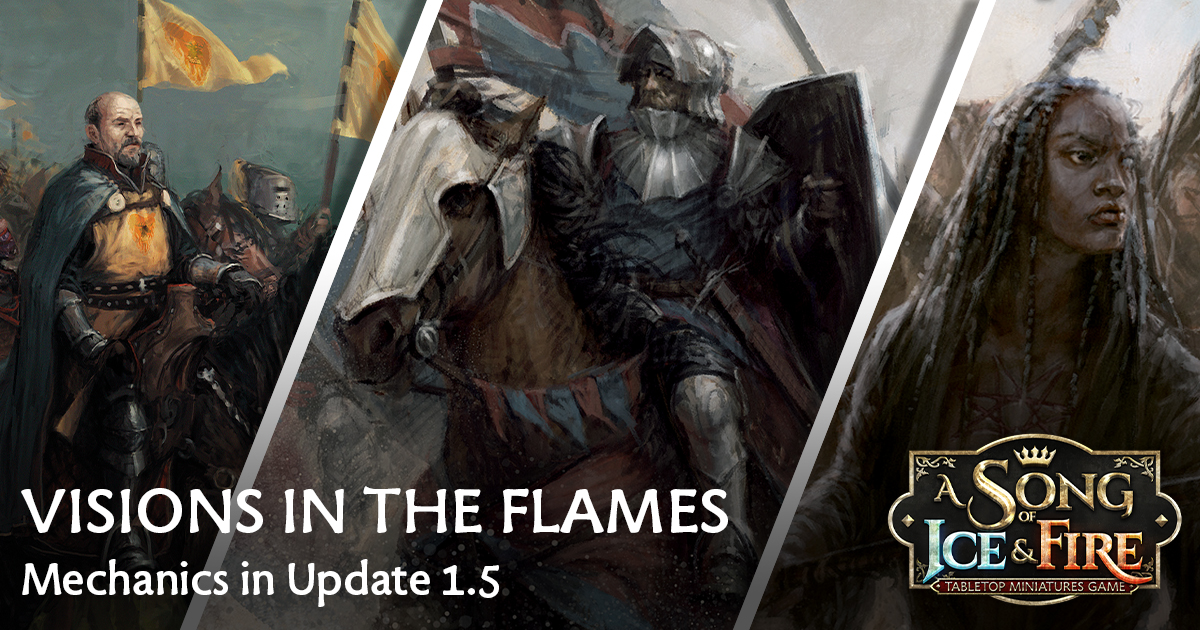Visions in the Flames: Mechanics in Update 1.5
We continue our look into the upcoming 1.5 release with a focus on some of the actual mechanic changes that will be appearing in the rulebook. Before we get too far into things, if you haven’t checked out Part 1 of our series, please click here to do so.
In every revision of the rulebook since release we’ve made a few minor tweaks here and there to areas that have caused confusion for players - wording adjustments, clarifications, more examples, etc - and 1.5 is no exception to that. In all these cases, no actual rules have been modified, amended, or changed, its just an effort to clean-up some spots. Of course all these, just like all other changes, are noted in the Errata Documents, so you can quickly check what’s a mere wording update and what is an actual change.
Today however, we’re taking a look at some actual mechanics changes that will be occurring with the update. This isn’t a comprehensive list, as some items will get their own dedicated article, but it should give a window into what to expect when 1.5 lands.
Just like last time, there are essentially three “levels” of changes we’re doing when it comes to revising aspects of the Core Rules. The first example would be relatively minor modifications or changes. An example of this being Surge Forth. Currently, as the rule stands there can be some awkward timing conflicts and interactions that occur, specifically due to slight ambiguity in its exact timing. In 95%+ cases, it won’t come up, but in that remaining 5% that it does, it creates some unintuitive interactions (if you can’t think of any immediately, that’s perfectly normal - again, these are rare). While it may not seem worth it to modify a rule when the corner-cases are so low, this is also a facet that has potential to have more cases grow as time goes on and more content is released, so we’re taking the time to prevent that.
In this case, its just a clarification that the Surge Forth move happens only after any other Abilities, Effects, Cards, Triggers, etc. etc. have been resolved, essentially making it the very last thing that can happen in that instance. Again, this is pretty much how it functioned currently, outside of some specific cases. There aren’t a lot of these little corner-cases, since most of them have been removed and/or dealt with in previous updates, but this was one such that stood out and seemed worth addressing.
Alright, so now let’s talk about a couple “mid-range” style updates. Essentially these are changes that, while they do modify the core mechanics of the game, they do so in a way that really can’t be considered a drastic overhaul or modification. These are done in an effort to streamline situations that repeatedly keep coming up (much more than the 5% listed above) or, in the case here, modified to allow some greater tactical flexibility in the game.
In the current ruleset, Charging greatly favors the, well, Charger - to the point where it was almost impossible to prevent a unit from being charged without some extreme working by the defender. This meant that battle-line formations and positioning wasn’t as deep as it could be, specifically in the areas of “vanguard” positioning (e.g. units specifically positioned to guard the flanks of other units).
This section of the rules also caused the greatest number of misplays in how aligning and positioning were handled. While we had a call-out box dedicated to dealing with the technical of aligning, it was often still misplayed or done incorrectly, which would in turn lead to further issues.
By making the change listed above, which was be summarized as “you have to be able to make at least 50% contact to engage” it makes the criteria for “what happens in a charge” very cut-and-dry: By the new wording and criteria for charging, there is never a situation where the Defender’s tray is moved. Essentially, if you ever have to even consider moving the Defender’s tray, its not a legal charge to begin with (as the Attacker must have space to be positioned - there is no other option).
This means the Call-Out box fades into distant memory, as none of its rules apply any longer. Instead, we used the space to expand on what happens when you could potentially engage multiple enemies, which was another area that often required more detailed explanation than we really wanted to see. Once again, the rules for how to handle it have been re-worded to follow specific steps in resolution: If you can do A, then do A, if you cannot, then B, then C, and so forth.
The last type of change would be actual overhauls to some existing rules, of which there are two main sections we re-evaluated. While it may seem like a tease, we’re not going to go over those until Part 3, however, as they deserve an in-depth look. We mention them here, however, because when we do end up talking about them, we’re sure they’re going to become a community focus for discussion, but we feel the subtle changes will actually be the most impactful to the overall gaming experience, all things considered. So we’d like to keep the focus on them before we get into the deeper stuff.
Everything listed above, and everything to come has been done as a result of the collected data since the game’s release, from both continued internal development and external data as well, all to push the game to its best form. As we’ve mentioned before, this has been in the works for quite some time, so we’re excited to continually discuss it in the time leading up to the official release! Until next time!
